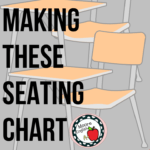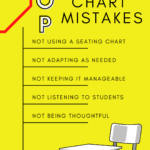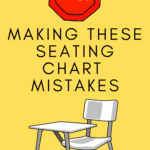Around the third week of the school year, I will hear from teachers struggling with classroom management. During the third week, students will probably begin to test your classroom management. So it is important to maintain consistent expectations. The classroom belongs to the students, but teachers make sure the classroom environment invites learning. That’s where seating charts come in!
When teachers approach me with classroom management concerns, I almost always ask about their seating chart. From these conversations, I have put together a list of 5 seating chart mistakes.

This post this post may contain affiliate links. Please read the Terms of Use.
Seating Chart Mistakes
Not using a seating chart. A seating chart makes it easier to learn student names. More importantly, using a seating chart from the first day lets students know that you are serious about creating an environment the emphasizes learning. A lot of the first day of school focuses on establishing classroom management and mutual respect. And greeting students at the door with a smile and a seating chart goes a long way toward achieving these goals.
Not adapting the seating chart as needed. My first-day seating chart rarely makes it out of the first week. By the end of the first week, I have a better idea of which students are struggling academically. I know which ones are chatty. And I know which ones are independent. Move students around as needed. Often times, you can adapt a seating chart by shifting one or two students. If the seating chart is working for 90% of students, then there’s no need to move everyone. Instead, quietly catch the one or two students you need to move and explain that you are changing their assigned seat. If I am moving a student for behavior reasons, I often ask them why they think I’m moving them. And then we can have a reflective conversation about classroom behavior.
Not making the seating arrangement manageable. When you set up your classroom, make sure the desk configuration fits your classroom needs. For example, my first room was very small, so desk pods did not work. There wasn’t enough room! In the same vein, make sure your desk configuration fits your management needs. A lot of my classroom procedures are designed to empower students. But if the seating chart prevents them for reaching the turn-in tray or the pencil sharpener, then the seating chart is causing more problems than it’s solving. Finally, the seating chart should serve curricular needs. For example, rigid rows may not fit a collaborative curriculum, such as yearbook or civic leadership.
Not listening to students. While using a seating chart is partially about classroom organization, your students will tell you when something doesn’t work. If a student asks to be moved, at least listen to their reasons for wanting to be moved. Most of the time, I only move students for academic reasons. But simply listening to students’ reasons for wanting to be moved can go a long way in building relationships with students. After listening to a student, I can usually help them figure out how to solve their own problem.
Creating Thoughtful Seating Charts
The last mistake is not thinking through the seating chart. A lot of teachers just use alphabetical order for the seating chart. And while that may be helpful for learning names, it is not the best choice in terms of classroom management. For one thing, your students know the people that sit near them alphabetically. So you are inviting them to chat or make social (rather than academic) decisions. Furthermore, the best seating charts are thoughtful. Here are my suggestions for creating a thoughtful seating chart.
- Begin with IEPs and 504s. Make sure you are honoring any calls for preferential seating, including open bathroom passes. Seat students so as to maximize their abilities.
- Next, check out students’ standardized test scores. While you cannot know everything about a student from a set of scores, you may be able to make some inferences about which students will have the highest need in your content area. For this reason, I sit students with the lowest scores in reading and English on the inside edges of the room where I can most easily see their work and monitor and adjust.
- Then, pay special attention to the least-accessible parts of the classroom. Who you place in the back corners is important. If at all possible, seat your independent students in these locations. Keep in mind that the most independent students are not always the ones with the highest test scores.
- Finally, consider gender. This is old school. But I try not to clump all my students who identify as female or male in one section of the room.
With the school year approaching, I hope this list helps you create a more manageable classroom that better facilitates student learning. I know I would be lost without seating charts. With this list, everyone should be able to make it through that third week of school! What tips do you have? How do you handle seating in your secondary classroom? Let us know in the comments.

















